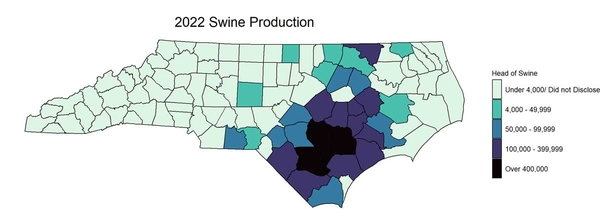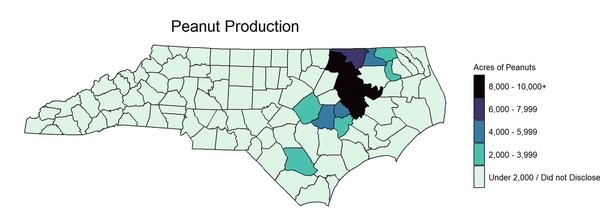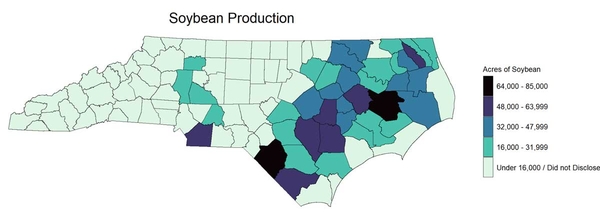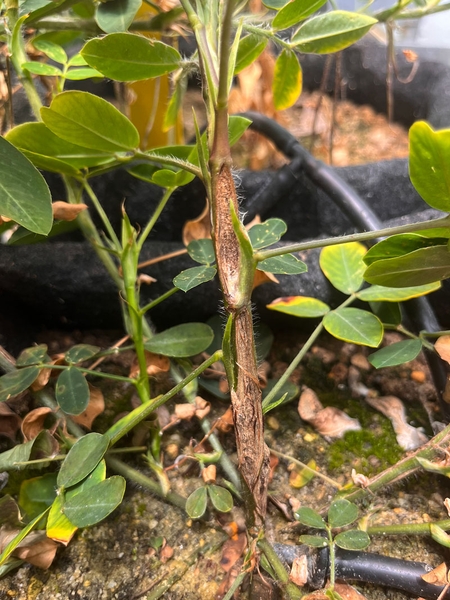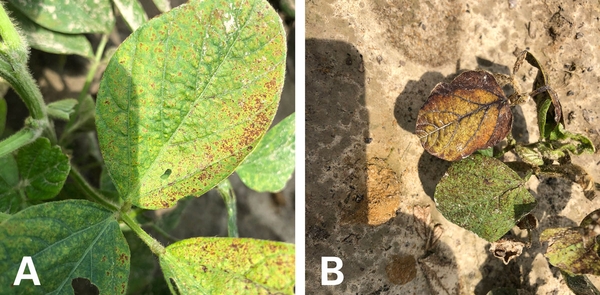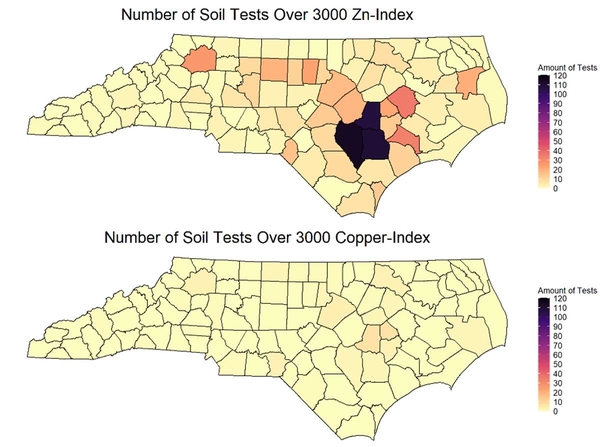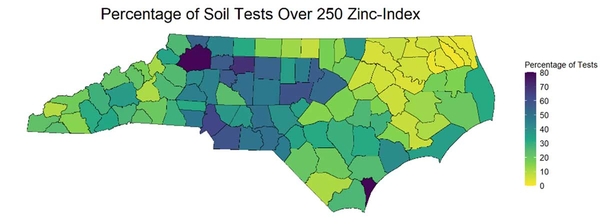Introduction
With nearly 70% of farm cash receipts coming from livestock, dairy, and poultry in 2021, North Carolina is a significant animal production state. Large poultry and swine industries rank amongst the largest in production in the United States (Figure 1a and Figure 1b). The manure produced by these industries is an excellent source of fertility for crop production, providing farmers an abundance of desired nitrogen, phosphorus, and potassium. It is important to acknowledge, however, that in addition to these key macronutrients, manure application also introduces micronutrients. While micronutrients are often beneficial to crop production, issues may arise with the accumulation of metals in soils. Zinc and copper, specifically, can reach levels toxic to plants. These metals are often utilized in livestock and poultry operations as feed supplements, growth promoters, or antimicrobials and are necessary for animal production. Understanding the extent of zinc and copper accumulation in agricultural soils is crucial to inform management decisions within the livestock and poultry industries to avoid these issues.
Where Do Zinc and Copper Come From?
Zinc and copper are key nutrients or antimicrobials in animal feed or useful antimicrobials for disinfection (such as copper sulfate rinses or foot baths). These micronutrients promote growth in animals, aiding in enzyme systems and biochemical reactions. While portions of these nutrients are absorbed by the animals, the vast majority are excreted in the manure. In addition, manure application rates are almost exclusively determined based on the nitrogen content of the manure. This practice, however, leads to the inadvertent over-application of zinc and copper to soils.
Why Are Zinc and Copper a Concern?
Too much zinc or copper can cause crop toxicity, which can reduce yields or render the field unusable. The two most common crops with reported zinc toxicity symptoms in North Carolina are peanut and soybean, which constitute a large area of production throughout the state but are grown predominantly in the coastal plain of North Carolina according to the United States Department of Agriculture (Figure 2a and Figure 2b). North Carolina currently ranks 5th in the United States in peanut production and 17th in soybean production. Peanuts are especially susceptible to zinc, and current recommendations are to not exceed a soil zinc index of 300 (Table 1; Figure 3). Soybean toxicity has been reported following multiple years of biosolids or poultry litter application or after a one-time application of swine sludge in which soil zinc indexes exceed 2000, resulting in toxicity symptoms (Figure 4). In addition, regulations state that no manure or zinc/copper-containing byproduct should be applied to soils with a zinc or copper index above 3000 (Figure 4). Therefore, even if a grower doesn’t intend to grow peanuts, it is important to keep an eye on soil zinc and copper levels to avoid toxicity in other crops or to maintain access to existing land application sites.
Where Are We Seeing High Zinc and Copper?
Through analysis of over 720,000 soil samples (from 2017 to 2019) provided by the Soil Testing Section of the North Carolina Department of Agriculture and Consumer Services, the highest levels of zinc and copper are seen in the piedmont in areas with high broiler production (Figure 6). This trend continues in the southern coastal plain, consisting of counties that are most notable for swine, turkey, and broiler production. One might think the coastal plain is in a better position due to low existing soil zinc and copper levels. Much of the zinc and copper from swine operations, however, is currently held in the sludge at the bottom of anaerobic treatment lagoons on swine farms which, when emptied, can have drastic effects on soil zinc and copper levels (Figure 7). Also, the sandy soils of the coastal plain require less zinc to show toxicity symptoms compared to the heavier soils found in the piedmont.
Ways to Avoid Issues Before They Arise
Soil Testing
A soil sample should be collected every two to three years to provide an accurate picture of current nutrient levels (see Extension publication AG-439-30, Careful Soil Sampling—The Key to Reliable Soil Test Information). Results from a soil test can provide farms with a guideline for the amount of manure or biosolids that could be applied and whether any issues could arise from further application. When considering application of manure or biosolids, it is important to understand the current levels of zinc and copper in the soil to determine how additional manure could affect crop production. To get a quick estimate of how manure application could increase the soil zinc index, divide the pounds of zinc you are planning to apply per acre by 0.071. This will give a conservative estimate of the intended application, but you must have a current waste analysis. For example, if you are applying a broiler litter with 0.8 lb of Zn/ton at a rate of 4 tons per acre, you would anticipate an increase in Zn-I of 45 above current soil test levels (0.8 lb Zn/ton × 4 tons/ac ÷ 0.071 conversion factor = 45 zinc-index increase).
Manure Testing
A current, representative waste analysis is necessary to determine application rates of macronutrients such as nitrogen, phosphorus, potassium, and micronutrients such as zinc and copper (see Extension publication AG-439-33, Waste Analysis). Results from these tests will help you determine the appropriate application rate for different crops, as well as the appropriate crops that should receive manure.
Accurate Record Keeping
After testing of soil and manure, maintaining accurate and thorough records of fertilizer (organic and inorganic) applications will aid in keeping soil levels within the appropriate range to maximize crop production. Any history of spills, equipment breakdowns, or misapplications could help explain localized toxicity symptoms, and areas where overapplication has occurred should be avoided in future applications. Also, areas where an old structure has been removed can show toxicity due to zinc deposition from galvanized roofing, and old manure stockpiling areas are common causes of toxicity issues in fields. Keeping track of these areas can help explain issues should they arise.
Accurate Application Rates
Nutrient management planning only works if the target application rate is achieved. Studies show that “eyeballing” the application rate often results in gross overapplication, which can be devastating when applying high zinc or copper containing materials, such as swine sludge from a nursery operation. It is important to calibrate spreader equipment or confirm the company performing the work has calibrated their equipment.
Aligning Feed Supplementation with Current Recommendations
Least cost formulation software is programmed to maximize nutrients while minimizing the cost to develop and manufacture diets. Unfortunately, challenges associated with subsequent manure management are generally not considered in the feed formulation process. It is, however, gaining popularity with feed industry nutritionists and feed manufacturers, especially in areas with strict regulations on phosphorus application. The current nutrient recommendations for livestock and poultry vary based on the animal and life stage, and the National Research Council (NRC) has published appropriate minimum recommendations for the nutrition of different farm animals (Current National Research Council Reports). Formulating animal diets based on these recommendations will allow farmers to maximize nutrient intake of their livestock without over supplementing, which minimizes zinc, copper, and other nutrients in manure. However, it is also important to understand other factors that could justify increased zinc usage in animal feeds. Zinc is known to chelate with other compounds found in feed, such as phytate. This process renders the chelated mineral unavailable to the animal and results in the zinc being excreted. Zinc is often over formulated in diets to compensate for losses due to chelation during the digestion process. Zinc has also been shown to have antimicrobial properties, and increased supplementation can be helpful in diets that are formulated for No Antibiotics Ever (NAE) or Antibiotic Free (ABF) animals. Dietary supplementation of inorganic zinc is also often supplemented well above requirements as cost-effect means to prevent diarrhea and gut health problems in weanling pigs. Copper is often supplemented to prevent crop mycosis and protozoal infections in poultry.
Utilizing Alternative Zinc and Copper Supplements
The addition of zinc to animal feeds is beneficial and necessary for enzyme systems in animals, and the most common form of zinc found in livestock and poultry feed is feed grade zinc oxide. However, studies have shown that organic forms of zinc can not only improve animal performance but have also demonstrated greater bioavailability in animals. This increased bioavailability of zinc allows for a lower dosage, which would result in lower total zinc in manure. Similarly, copper sulfate is used to correct copper deficiencies in livestock and is the typical form of copper added to animal feeds to promote growth. Much like organic forms of zinc, experiments with organic forms of copper have demonstrated greater efficiency and bioavailability in livestock feed. While the costs of alternative sources of zinc and copper are higher, these options could provide value by minimizing the occurrence of zinc and copper toxicity from manure applications by reducing the overall zinc and copper use in animal feeds. Complete elimination of zinc and copper from livestock and poultry diets, however, is not realistic, and other uses discussed previously (diarrhea prevention and gut health) might limit the ability to reduce these metals within these diets.
Mitigation Strategies
Although prevention is the best management strategy, some soils already contain high levels of soil zinc and copper, resulting in crop toxicity symptoms or complete crop failure and death. Unfortunately, there are few mitigation strategies available, which include soil turnover and pH modification.
Soil Turnover
Deep tillage is one mitigation strategy used to distribute micronutrients more evenly throughout the soil profile through soil mixing. This strategy is likely to be most effective in long term no-till or minimum tillage situations, where nutrients can accumulate at the soil surface. To utilize this method, sample the soil to the maximum depth of your tillage equipment and no deeper than the bottom of the A horizon. Separate soil cores into increments of 2 to 4 inches and submit the sampling depths as separate soil samples for analysis. It is important to collect multiple samples at each depth to get a representative sample of the zinc stratification in your field. If no zinc or copper stratification exists, tillage would not be an appropriate mitigation strategy, as no dilution of zinc would take place with mixing. If there is stratification, deep tillage would be a viable mitigation option, but it can only be used once. Once the soil is thoroughly mixed, stratification will no longer exist, and it is unlikely to help in the future. Therefore, you should only use this practice once and stop applying animal waste or any zinc containing material. If you have variability in toxicity symptoms across the field, it may not be necessary to till the entire field. Focusing on “hot spots” that show the most severe toxicity symptoms could help alleviate the most severe issues. Limitations exist in areas with shallow depth to bedrock, rocky soils, and fields with acidic subsoils.
Soil pH Modification
Adjusting soil pH can reduce the effects of phytotoxicity caused by excess zinc and copper. Liming soils to a higher pH reduces the availability of zinc and copper in the soil solution, providing some relief from phytotoxic effects of these elements. We recommend that producers lime to a pH of 6.5 to 6.8 if experiencing confirmed zinc or copper toxicity. Liming the soil will probably reduce the availability of other micronutrients, such as manganese. Therefore, it is very important to scout your fields and look for manganese deficiency symptoms. If manganese deficiency arises, apply foliar manganese to alleviate these symptoms.
Because plants take up very little zinc and copper, toxicity symptoms are sometimes impossible to completely resolve, and mitigation strategies—such as soil turnover or pH modification—are the only options. It is critically important to avoid zinc and copper accumulation to these levels, as some fields would require 300 or more years of cropping to remove the accumulated metals. Zinc and copper toxicity can require generational change in management, necessitating a change in cropping systems to maintain production on historically productive land.
Publication date: March 27, 2024
AG-957
N.C. Cooperative Extension prohibits discrimination and harassment regardless of age, color, disability, family and marital status, gender identity, national origin, political beliefs, race, religion, sex (including pregnancy), sexual orientation and veteran status.


